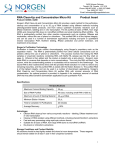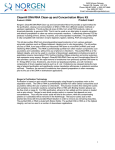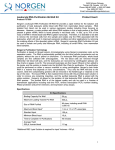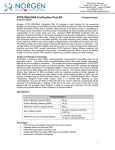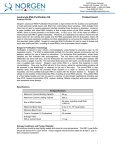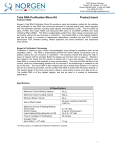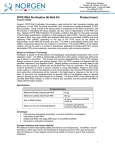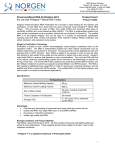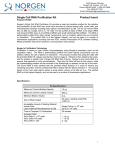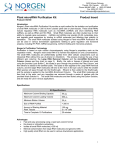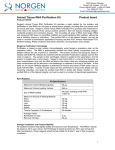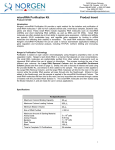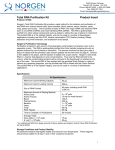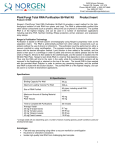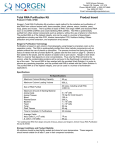Download 96-well - Norgen Biotek Corp.
Transcript
3430 Schmon Parkway Thorold, ON, Canada L2V 4Y6 Phone: 866-667-4362 (905) 227-8848 Fax: (905) 227-1061 Email: [email protected] RNA Clean-Up and Concentration 96-Well Kit Product Insert Product # 25100 Norgen’s RNA Clean-Up and Concentration 96-Well Kit provides a rapid method for the purification, cleanup and concentration of up to 50 g of RNA isolated using different methods including phenol/guanidine-based protocols, and from various upstream enzymatic reactions such as DNase treatment, labeling and in vitro transcription. The kit purifies all sizes of RNA, from large mRNA and ribosomal RNA down to microRNA (miRNA) and small interfering RNA (siRNA). The RNA is preferentially purified from other reaction components such as proteins, RNases and nucleotides, without the use of phenol or chloroform. The purified RNA is of the highest integrity, and can be used in a number of downstream applications including end-point or quantitative reverse transcription PCR, Northern blotting, RNase protection and primer extension, and expression array assays. Norgen’s Purification Technology Purification is based on 96-well column chromatography using Norgen’s proprietary resin as the separation matrix. The RNA is preferentially purified from other cellular components such as proteins without the use of phenol or chloroform. The process involves first mixing the RNA samples or enzymatic reactions containing RNA with Buffer RL (please see the flow chart on page 4). Ethanol is then added and the mixture is loaded onto a 96-Well Plate. Norgen’s resin binds RNA in a manner that depends on ionic concentrations. Thus only the RNA will bind to the resin in the wells, while the contaminating proteins or nucleotides will be removed in the flowthrough. The bound RNA is then washed three times with the provided Wash Solution A in order to remove any remaining impurities, and the purified RNA is eluted with the Elution Solution A. The purified RNA is of the highest integrity, and can be used in a number of downstream applications. Norgen’s RNA Clean-Up and Concentration 96-Well Kit purifies RNA with minimal amounts of DNA contamination. An optional protocol is provided in Appendix A for maximum removal of residual DNA that may affect sensitive downstream applications such quantitative PCR. Specifications Kit Specifications Binding Capacity per Well 50 g Size of RNA Purified All sizes, including small RNA (<200 nt) Maximum Amount of Starting Material: 50 g of RNA Minimum Elution Volume 75 L Time to Complete 10 Purifications 30 minutes Average Recovery > 90% Advantages Efficient RNA cleanup from various enzymatic reactions – labeling, DNase treatment and in vitro transcription Cleanup of RNA isolated using different methods, including phenol/chloroform extractions Fast and easy processing using either a vacuum manifold or centrifugation Suitable for all sizes of RNA, from large rRNA down to microRNA (miRNA) No phenol or chloroform extractions 1 Kit Components Component Buffer RL Wash Solution A Elution Solution A 96-Well Plate Adhesive Tape 96-Well Collection Plate 96-Well Elution Plate Product Insert Product # 25100 (192 preps) 2 x 40 mL 2 x 38 mL 2 x 20 mL 2 4 2 2 1 Storage Conditions and Product Stability All solutions should be kept tightly sealed and stored at room temperature. These reagents should remain stable for at least 2 years in their unopened containers. Precautions and Disclaimers This kit is designed for research purposes only. It is not intended for human or diagnostic use. Ensure that a suitable lab coat, disposable gloves and protective goggles are worn when working with chemicals. For more information, please consult the appropriate Material Safety Data Sheets (MSDSs). These are available as convenient PDF files online at www.norgenbiotek.com. Customer-Supplied Reagents and Equipment You must have the following in order to use the RNA Clean-up and Concentration 96-Well Kit: For All Protocols For Vacuum Format: o Vacuum manifold with vacuum pump capable of generating a minimum pressure of -650 mbar or -25 in. Hg (such as Whatman UniVac 3 Vacuum to Collect Manifold) o Sealing tape or pads For Centrifuge Format: o Centrifuge with rotor for 96-well plate assembly (such as Thermo Fisher IEC Centra CL3 series or Beckman GS-15R) For RNA Clean-Up and Concentration from Enzymatic Reactions or Non-Phenol/GuanidineBased RNA Isolation Methods -mercaptoethanol 96 - 100% ethanol RNase-free or DEPC-treated water For RNA Clean-Up and Concentration from Phenol/Guanidine-Based RNA (Trizol or Tri Reagent) Isolation Methods 70% ethanol 2 Working with RNA RNases are very stable and robust enzymes that degrade RNA. Autoclaving solutions and glassware is not always sufficient to actively remove these enzymes. The first step when preparing to work with RNA is to create an RNase-free environment. The following precautions are recommended as your best defense against these enzymes. The RNA area should be located away from microbiological work stations Clean, disposable gloves should be worn at all times when handling reagents, samples, pipettes, disposable tubes, etc. It is recommended that gloves are changed frequently to avoid contamination There should be designated solutions, tips, tubes, lab coats, pipettes, etc. for RNA only All RNA solutions should be prepared using at least 0.05% DEPC-treated autoclaved water or molecular biology grade nuclease-free water Clean all surfaces with commercially available RNase decontamination solutions When working with purified RNA samples, ensure that they remain on ice during downstream applications 3 Flow Chart Procedure for Purifying RNA using Norgen’s RNA Clean-up and Concentration 96-Well Kit RNA Sample Add Buffer RL Add ethanol Bind RNA Wash three times with Wash Solution A Elute RNA with Elution Solution A Purified Total RNA 4 Procedures For Vacuum Manifold: All vacuum steps are performed at room temperature. The correct pressure can be calculated using the conversions: 1 mbar = 100 Pa = 0.0394 in. Hg = 0.75 mm Hg = 0.0145 psi For Centrifugation: All centrifugation steps are performed at room temperature. The correct rpm can be calculated using the formula: RPM = RCF (1.118 x 10-5) (r) where RCF = required gravitational acceleration (relative centrifugal force in units of g); r = radius of the rotor in cm; and RPM = the number of revolutions per minute required to achieve the necessary g-force. Notes Prior to Use There are 2 different Sample Preparation steps depending upon the RNA isolation method used. For RNA clean-up and concentration from enzymatic reactions or nonphenol/guanidine-based RNA isolation methods please follow Section 1A. For RNA clean-up and concentration from phenol/guanidine-Based RNA (Trizol or Tri Reagent) isolation methods please follow Section 1B. Once the sample has been prepared RNA clean-up can be performed using either a vacuum manifold or centrifugation. For purification using vacuum, please follow the procedure outlined in Section 2A. For purification using centrifugation, please follow the procedure outlined in Section 2B. Ensure that all solutions are at room temperature prior to use. Prepare a working concentration of the Wash Solution A by adding 90 mL of 96 - 100% ethanol (provided by the user) to the supplied bottles containing the concentrated Wash Solution A. This will give a final volume of 128 mL. The label on the bottles has a box that may be checked to indicate that the ethanol has been added. It is recommended that no more than 50 g of RNA to be used per cleanup. The volumes stated in each procedure for input preparation are the volumes required to prepare samples for each well of the 96-well plate. It is important to work quickly during this procedure. This kit purifies RNA with minimal amounts of DNA contamination. However, an optional protocol is provided in Appendix A for maximum removal of residual DNA that may affect sensitive downstream applications such as quantitative PCR. The procedure in Appendix A is to be carried out prior to performing the kit procedure below. Section 1. Sample Preparation A. Sample Preparation for RNA Clean-Up and Concentration from Enzymatic Reactions or Non-Phenol/Guanidine-Based RNA Isolation Methods Notes Prior to Use Prepare an appropriate amount of Buffer RL by adding 10 L of -mercaptoethanol (provided by the user) to each 1 mL of Buffer RL required. -mercaptoethanol is toxic and should be dispensed in a fume hood. 5 1. Sample Preparation a. Adjust the volume of the RNA sample to 100 L by adding RNase-free or DEPC-treated water. It is recommended that no more than 50 g of RNA be used for each well. b. Add 200 L of Buffer RL to the RNA sample. Mix by vortexing c. Add 120 L of 96 – 100% ethanol (provided by the user) to the mixture from step 1b. Mix by vortexing for 10 seconds. d. RNA purification can now be performed using either a vacuum manifold or centrifugation. For purification using vacuum, please follow the procedure outlined in Section 2A. For purification using centrifugation, please follow the procedure outlined in Section 2B. B. Sample Preparation for RNA Clean-up and Concentration from Phenol/Guanidine-Based RNA (Trizol or Tri Reagent) Isolation Methods Notes Prior to Use The loading capacity of each well in the 96-Well Plate is 500 L. Depending on the aqueous phase volume after the phase separation, the subsequent binding step may need to be repeated once or more. For example, if the aqueous phase volume is 500 L, an additional 500 L of 70% EtOH will be added for a final volume of 1 mL. The binding will be repeated once in order to have all input passed through the column. 1. Sample Preparation a. Isolate RNA using a phenol/guanidine-based reagent such as Trizol or Tri Reagent, according to manufacturer’s instruction. After the separation of the aqueous and organic phases, collect the upper (aqueous) fraction containing the RNA into a new RNase-free microcentrifuge tube (not provided). Note the volume. b. Add one volume of 70% ethanol (provided by the user) to the fraction from step 1a. Mix by vortexing for 10 seconds. c. RNA purification can now be performed using either a vacuum manifold or centrifugation. For purification using vacuum, please follow the procedure outlined in Section 2A. For purification using centrifugation, please follow the procedure outlined in Section 2B. Section 2. RNA Clean-Up and Concentration from All Types of Input Note: The purification of RNA mix prepared in Section 1 could be performed using either a vacuum manifold or centrifugation. For purification using vacuum, please follow the procedure outlined in Section 2A. For purification using centrifugation, please follow the procedure outlined in Section 2B A. RNA Clean-Up and Concentration Using Vacuum Manifold 1. Binding RNA to 96-Well Plate a. Assemble the 96-Well Plate and the vacuum manifold according to manufacturer’s recommendations. Note: The provided 96-Well Collection Plate can be used as the collection/waste tray if desired. 6 b. Apply up to 500 L of the input with the ethanol (from Section 1) into each well of the 96Well Plate. Tape the plate or any unused wells using sealing tape or pads (provided by the user) according to the vacuum manifold manufacturer’s recommendations. Apply vacuum for 2 minutes. Note: Depending on the starting material, a small quantity of precipitates may appear in the input-ethanol mix. No additional step is required to remove these precipitates prior to application of the mixture to the wells. c. Turn off vacuum and ventilate the manifold. Discard the flowthrough. Reassemble the 96-Well Plate and the vacuum manifold. Note: Ensure that all of the input from each well has passed through into the collection/waste tray. If the entire input volume has not passed, apply vacuum for an additional 2 minutes. d. If the input RNA mix volume is greater than 500 L, repeat Step 1a to Step 1c until all the input has passed through the 96-Well Plate. 2. RNA Wash a. Apply 400 L of Wash Solution A to each well of the 96-Well Plate. Tape the plate or any unused wells using sealing tape or pads (provided by the user) according to the vacuum manifold manufacturer’s recommendations. Apply vacuum for 2 minutes. Note: Ensure the entire Wash Solution A has passed through into the collection/waste tray by inspecting the 96-Well Plate. If the entire wash volume has not passed, apply vacuum for an additional 2 minutes. b. Turn off vacuum and ventilate the manifold. Discard the flowthrough. c. Reassemble the 96-Well Plate and the vacuum manifold. Repeat steps 2a and 2b to wash column for a second time. d. Reassemble the 96-Well Plate and the vacuum manifold. Repeat steps 2a and 2b to wash column for a third time. e. Pat the bottom of the 96-Well Plate dry. Reassemble the 96-Well Plate and the vacuum manifold. Apply vacuum for an additional 5 minutes in order to completely dry the plate. f. Turn off vacuum and ventilate the manifold. 4. RNA Elution a. Remove the lid from the provided Elution Plate. Replace the collection/waste tray in the vacuum manifold with the Elution Plate. Complete the vacuum manifold assembly with the 96-Well Plate. b. Add 75 L of Elution Solution A to each well of the plate. c. Apply vacuum for 2 minutes. 5. Storage of RNA Use the provided adhesive tape and/or lid to seal the Elution Plate. The purified RNA samples may be stored at –20°C for a few days. It is recommended that samples be placed at –70°C for long term storage. 7 B. RNA Clean-Up and Concentration Using Centrifugation 1. Binding RNA to 96-Well Plate a. Place the 96-Well Plate on top of a provided 96-Well Collection Plate. b. Apply up to 500 L of the input with the ethanol (from Section 1) into each well of the 96Well Plate. Centrifuge the assembly at maximum speed or 3,000 x g (~3,000 RPM) for 2 minutes. Note: Depending on the starting material, a small quantity of precipitates may appear in the input-ethanol mix. No additional step is required to remove these precipitates prior to application to the wells c. Discard the flowthrough. Reassemble the the 96-Well Plate and the bottom plate. Note: Ensure that all of the input from each well has passed through into the bottom plate. If the entire input volume has not passed, centrifuge for an additional 2 minutes. d. If the input RNA mix volume is greater than 500 L, repeat Step 1a to Step 1c until all the input has passed through the 96-Well Plate. 2. RNA Wash a. Apply 400 L of Wash Solution A to each well of the 96-Well Plate. Centrifuge the assembly at maximum speed or 3,000 x g (~3,000 RPM) for 2 minutes. Note: Ensure the entire Wash Solution A has passed through into the bottom plate by inspecting the 96-Well Plate. If the entire wash volume has not passed, centrifuge for an additional 2 minutes. b. c. d. e. Discard the flowthrough. Reassemble the 96-Well Plate and the bottom plate. Repeat steps 2a and 2b to wash column for a second time. Repeat steps 2a and 2b to wash column for a third time. Pat the bottom of the 96-Well Plate dry. Reassemble the 96-Well Plate and the bottom plate. Centrifuge the assembly at maximum speed or 3,000 x g (~3,000 RPM) for 5 minutes in order to completely dry the plate. 4. RNA Elution a. Remove the lid from the provided Elution Plate. Stack the 96-Well Plate on top of the Elution Plate. b. Add 75 L of Elution Solution A to each well of the 96-Well Plate. c. Centrifuge the assembly at maximum speed or 3,000 x g (~3,000 RPM) for 2 minutes. 5. Storage of RNA Use the provided adhesive tape and/or lid to seal the Elution Plate. The purified RNA sample may be stored at –20°C for a few days. It is recommended that samples be placed at –70°C for long term storage. 8 Appendix A Protocol for Optional On-Column DNA Removal Norgen’s RNA Clean-Up and Concentration 96-Well Kit isolates total RNA with minimal amounts of genomic DNA contamination. However, an optional protocol is provided below for maximum removal of residual DNA that may affect sensitive downstream applications. It is recommended that Norgen’s RNase-Free DNase I Kit (Product # 25710) be used for this step. 1. For every on-column reaction to be performed, prepare a mix of 10 L of DNase I and 65 µL of Enzyme Incubation Buffer using Norgen’s RNase-Free DNase I Kit (Product # 25710). Mix gently by inverting the tube a few times. DO NOT VORTEX. Note: If using an alternative DNase I, prepare a working stock of 0.25 Kunitz unit/L RNase-free DNase I solution according to the manufacturer’s instructions. A 75 L aliquot is required for each column to be treated. 2. Perform the appropriate RNA Cleanup Procedure for your starting material up to and including “Binding RNA to 96-Well Plate” (Steps 1 and 2 of all protocols) 3. For Vacuum Manifold: Apply 400 L of Wash Solution A to each well of the 96-Well Plate. Tape the plate or any unused wells using sealing tape or a pad (provided by the user) according to the vacuum manifold manufacturer’s recommendations. Apply vacuum for 2 minutes. For Centrifugation: Apply 400 L of Wash Solution A to each well of the 96-Well Plate. Centrifuge the assembly at maximum speed or 3,000 x g (~3,000 RPM) for 2 minutes. 4. Discard the flowthrough. Reassemble the 96-Well Plate with the vacuum manifold or the bottom plate. 5. Apply 75 L of the RNase-free DNase I solution prepared in Step 1 to each well of the 96Well Plate. For Vacuum Manifold: Apply vacuum for 30 seconds. For Centrifugation: Centrifuge the assembly at maximum speed or 3,000 x g (~3,000 RPM) for 30 seconds. 6. After the centrifugation or vacuum in Step 5, pipette the flowthrough that is present in the collection plate back onto the top of the column. Note: Ensure Step 6 is performed in order to ensure maximum DNase activity and to obtain maximum yields of RNA, in particular for small RNA species o 7. Incubate the assembly at 25 - 30 C for 15 minutes. 8. Without any further centrifugation, proceed directly to “RNA Wash” Section 2A, Step 3b for Vacuum Manifold procedure or Section 2B, Step 3c for Centrifugation procedure. 9 Troubleshooting Guide Problem Poor RNA Recovery Clogged Wells in Plate RNA is Degraded Possible Cause Solution and Explanation Wells of the plate have become clogged Do not exceed the recommended amounts of starting materials. The amount of starting material may need to be decreased if the wells of the plate show clogging below the recommended levels. See also “Clogged Wells in Plate” below. An alternative elution solution was used It is recommended that the Elution Solution A supplied with this kit be used for maximum RNA recovery. Ethanol was not added to the input Ensure that the appropriate amount of ethanol is added to the input before binding to the column. Ethanol was not added to the Wash Solution A Ensure that 90 mL of 96 - 100% ethanol is added to the supplied Wash Solution A prior to use. High amounts of RNA in the input Ensure that no more than 50 g of RNA is used as the input for each well of the plate. High amounts of genomic DNA present in sample The input may be passed through a 25 gauge needle attached to a syringe 5-10 times in order to shear the genomic DNA prior to loading onto the column. Centrifuge temperature too low Ensure that the centrifuge remains at room temperature throughout the procedure. Temperatures below 15°C may cause precipitates to form that can cause the wells to clog. Insufficient Vacuum Ensure that a vacuum pressure of at least -650 mbar or 25 in. Hg is developed RNase contamination RNases may be introduced during the use of the kit. Ensure proper procedures are followed when working with RNA. Please refer to “Working with RNA” at the beginning of this user guide. Procedure not performed quickly enough In order to maintain the integrity of the RNA, it is important that the procedure be performed quickly. Improper storage of the purified RNA For short term storage RNA samples may be stored at –20°C for a few days. It is recommended that samples be stored at –70°C for longer term storage. 10 Problem RNA does not perform well in downstream applications DNA or Genomic DNA contamination Possible Cause Solution and Explanation RNA was not washed three times with the provided Wash Solution A Traces of salt from the binding step may remain in the sample if the column is not washed three times with the Wash Solution A. Salt may interfere with downstream applications, and thus must be washed from the column. Ethanol carryover Ensure that the dry spin under the Column Wash procedure is performed, in order to remove traces of ethanol prior to elution. Ethanol is known to interfere with many downstream applications. Large amounts of starting material used Perform RNAse-free DNaseI digestion on the RNA sample prior to starting the protocol as outlined in Appendix A. Related Products Total RNA Purification Kit Cytoplasmic & Nuclear RNA Purification Kit Leukocyte RNA Purification Kit microRNA Purification Kit 100b RNA Ladder 1kb RNA Ladder Product # 17200 21000 21200 21300 15002 15003 Technical Support Contact our Technical Support Team between the hours of 8:30 and 5:30 (Eastern Standard Time) at (905) 227-8848 or Toll Free at 1-866-667-4362. Technical support can also be obtained from our website (www.norgenbiotek.com) or through email at [email protected]. 3430 Schmon Parkway, Thorold, ON Canada L2V 4Y6 Phone: (905) 227-8848 Fax: (905) 227-1061 Toll Free in North America: 1-866-667-4362 © 2014 Norgen Biotek Corp. PI25100-5-M14 11












